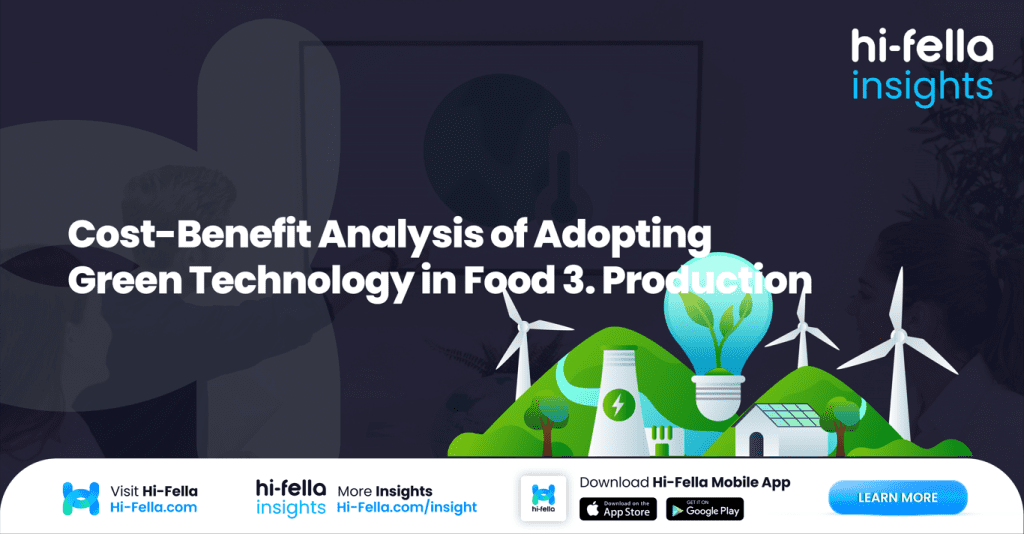Is going green in the food industry really worth it? Let’s break it down, dollars and sense.
Green technology has long shed its image of being a fringe luxury or a PR stunt. Today, it’s a real player in shaping the future of food production. But here’s the real question: is it financially viable?
That’s where cost-benefit analysis (CBA) comes in — the business world’s way of separating idealism from realism. In this article, we’ll walk you through what it really costs to go green in food production, and what kind of value (economic, environmental, social) you can expect to gain from that investment.
Spoiler alert: it’s not all dollars and cents — sometimes, it’s about consumer trust, brand reputation, and future-proofing your operations.
Understanding Green Technology in Food Production
Before we dive into cost spreadsheets and long-term ROI, let’s get clear on what “green technology” in the food industry really looks like. It’s tempting to imagine a few solar panels on the roof or cardboard boxes with green leaves printed on them — but that’s just the tip of the iceberg lettuce.
Green tech in food production is a whole ecosystem of innovation — a mix of tools, systems, and strategies designed to reduce environmental impact without sacrificing productivity or profitability.
So, what are we really talking about? Let’s unpack the core components.
Energy-Efficient Equipment: Doing More with Less
At the heart of any food processing facility is machinery — and here’s where a lot of waste happens. Green technology steps in with:
- Low-energy processing machinery: Equipment optimised for energy conservation without compromising speed or quality.
- Smart sensors: Think of them as fitness trackers for machines — monitoring temperature, pressure, and usage patterns to minimise excess consumption.
- Automated systems: AI-powered automation that ensures your production line only uses what it needs, when it needs it.
Why it matters: Less energy use means lower bills and fewer carbon emissions. Efficiency is the new sexy.
Water Recycling Systems: Because Every Drop Counts
Water is the lifeblood of agriculture and food production — but it’s also becoming increasingly scarce. Green tech is bringing forward intelligent systems like:
- Closed-loop water recycling: Where water used in production is treated and reused in-house instead of being discharged.
- Greywater systems: Filtering and repurposing lightly used water (e.g., from cleaning processes) for non-potable use.
- Smart irrigation: Sensors that detect soil moisture and weather data to avoid overwatering in farming operations.
Why it matters: With climate change tightening water access, reducing freshwater dependency is not just good PR — it’s a strategic move.
Sustainable Agriculture Inputs: Tech Meets Soil
Back on the farm, green technology is reshaping how we grow the stuff we eat:
- Organic and bio-based fertilisers: Reducing chemical runoff and soil degradation.
- Precision irrigation: GPS and satellite-enabled tools that water crops with pinpoint accuracy.
- Vertical farming & hydroponics: Soil-free, space-saving farming models using 90% less water and often no pesticides.
- AI-driven crop monitoring: Drones and machine learning models that track crop health, pest outbreaks, and harvest timing in real-time.
Why it matters: This is where sustainability meets yield. It’s smarter, faster farming — with far less environmental impact.
Clean Energy: Food Production Powered by the Sun (or Wind… or Waste)
Switching from fossil fuels to renewables isn’t just for tech campuses and eco-resorts. In food production, it can be game-changing.
- Solar panels: From powering entire processing facilities to supporting cold storage in rural areas.
- Wind turbines: Particularly useful in open-farm settings.
- Biomass energy: Turning organic waste (like corn husks or animal waste) into heat and electricity.
Why it matters: Clean energy reduces reliance on volatile fossil fuel prices and slashes emissions — and in many cases, it’s now cheaper than traditional energy sources.
Waste-to-Value Systems: Turning Trash into Treasure
Food production produces waste. Tons of it. But with the right tech, what used to be landfill material can become a revenue stream:
- Anaerobic digesters: Convert food scraps into biogas for electricity or heating.
- Composting units: Turn peels, pulp, and byproducts into organic fertiliser.
- Upcycling food waste: Repurposing “ugly” produce or scraps into new products — think fruit chips, broth, or even protein powder.
Why it matters: It’s cost-effective, environmentally sound, and looks amazing on your sustainability report.
Eco-Packaging Tech: Beyond the Brown Paper Bag
Packaging is one of the most visible — and problematic — areas of food production. Green packaging innovations are booming, including:
- Bioplastics: Made from plants like corn or cassava — biodegradable and compostable.
- Edible packaging: Yes, you can literally eat the wrapper. Popular in single-serve snack or dessert formats.
- Fully recyclable materials: Monomaterials and minimalist designs that reduce recycling complexity.
Why it matters: Consumers care deeply about packaging waste. Getting this right builds brand trust and helps reduce one of the biggest contributors to ocean plastic.
So, What’s the Big Picture?
These technologies — from smart water meters to AI-monitored greenhouses — aren’t isolated trends. They’re building blocks of a regenerative food system, one where sustainability and profitability aren’t opposing forces but powerful allies.
The ultimate goal? A supply chain that uses fewer resources, produces less waste, and delivers better outcomes — for the planet, for producers, and for people.
When you zoom out, green tech in food production isn’t just about saving money or getting a green certification. It’s about designing a system that feeds the world without breaking it.
Cost Considerations: The Not-So-Green Part of Going Green
Let’s address the elephant in the room — cost. Adopting green technology isn’t cheap, especially up front. But let’s get specific.
1. Initial Investment
The upfront cost can be significant:
- Solar panel installation: $200k–$1M depending on scale.
- Smart automation: $50k–$500k for full upgrades.
- Biodegradable packaging: 20–40% higher unit cost than plastic (at least for now).
- Water treatment systems: $100k+ depending on size.
2. Training & Transition
Your workforce might need upskilling to handle new tech. That means downtime, onboarding, and possibly hiring consultants.
3. Compliance & Certification
Green practices often require certifications (e.g., LEED, ISO 14001, organic certification), which come with audit and documentation costs.
4. Maintenance and Depreciation
Yes, green tech is often more durable, but still needs specialised maintenance. And some innovations depreciate fast as newer tech hits the market.
TL;DR: The upfront costs can be steep, but they’re investments — not just expenses.
The Benefits: Where It Pays Off (and It Really Does)
Alright, now let’s talk upside. Here’s where things get juicy.
1. Operational Savings
- Energy savings: Solar and efficient systems can cut utility bills by up to 60%.
- Water efficiency: Smart irrigation and recycling can reduce water bills and regulatory penalties.
- Less waste = less cost: Waste-to-energy or composting systems cut landfill costs and sometimes even generate income.
2. Consumer Demand & Brand Equity
Today’s customers want transparency, sustainability, and ethics — and they’re willing to pay more for it.
- 70% of consumers say sustainability is a deciding factor in their food purchases (source: NielsenIQ).
- Companies using sustainable packaging or sourcing often see 15–30% lift in brand preference.
3. Regulatory Incentives
- Carbon credits, grants, and subsidies are often available for green investments. Many countries now incentivise ESG-aligned businesses.
- Tax deductions for renewable energy and R&D spending are real and often underutilised.
4. Investor Attraction
Impact investing is growing fast. Green food companies often attract capital quicker, especially from ESG-aligned funds.
5. Resilience & Future-Proofing
- Adapting to climate-friendly practices early makes you more resistant to future regulations and climate shocks.
- Going green now means you won’t be scrambling later when governments start cracking down on carbon-heavy industries.
Case Studies: Proof on the Ground
1. Patagonia Provisions (USA)
Not just your favourite outdoor gear brand — they’re in food too. Using regenerative agriculture and recyclable packaging, they’ve built a loyal customer base and a brand that commands premium pricing.
2. Tanamera Coffee (Indonesia)
Invested in solar energy and eco-friendly packaging. Within 2 years, they cut energy costs by 40% and saw a 25% increase in international orders from eco-conscious markets.
3. Oatly (Sweden)
Built its entire identity on sustainability — oat-based milk with carbon footprint labels and recyclable packaging. Yes, they spend more per unit — but their IPO valuation? $10 billion. Consumers love transparency.
How to Approach a Cost-Benefit Analysis (CBA) for Your Business
Now the big question: should your business go green — and if so, how much green is worth the green?
Here’s a simplified framework to build your own CBA:
- Define Scope & Timeframe
- Are you measuring ROI in 1 year, 5 years, or 10? (Hint: green tech gets more attractive the longer your view.)
- Are you measuring ROI in 1 year, 5 years, or 10? (Hint: green tech gets more attractive the longer your view.)
- List All Costs
- Equipment, installation, training, compliance, maintenance.
- Equipment, installation, training, compliance, maintenance.
- Estimate Benefits
- Operational savings
- Increased sales
- Brand value
- Avoided costs (e.g., carbon taxes)
- Operational savings
- Monetise Intangibles
- This is tricky, but brand value and investor appeal are real. You can use market benchmarks or estimate based on customer growth.
- This is tricky, but brand value and investor appeal are real. You can use market benchmarks or estimate based on customer growth.
- Risk Assessment
- How sensitive are your numbers to energy prices, climate change risks, or supply chain volatility?
- How sensitive are your numbers to energy prices, climate change risks, or supply chain volatility?
- Calculate Net Present Value (NPV)
- If the NPV is positive, green tech isn’t just a feel-good move — it’s smart business.
- If the NPV is positive, green tech isn’t just a feel-good move — it’s smart business.
Challenges to Watch For
- Greenwashing traps: Half-committing to sustainability might hurt more than help.
- Lack of internal buy-in: If your team isn’t aligned, the tech won’t be used effectively.
- Consumer price sensitivity: Going green should never compromise affordability for your core audience.
Final Verdict: Green Tech is an Investment, Not a Cost
If you’re expecting instant ROI, green tech might disappoint. But if you’re in the food business for the long haul, the benefits are layered and meaningful: cost savings, brand power, risk mitigation, and a moral compass that points to a better future.
Going green isn’t just about saving the planet — it’s also about saving your business from becoming obsolete.
So, the real question isn’t “Can we afford to adopt green technology?”
It’s “Can we afford not to?”
Bonus: Green Tech Adoption Checklist for Food Producers
✅ Conduct energy & water audits
✅ Explore local subsidies & tax credits
✅ Start with low-hanging fruits (LEDs, insulation, smart meters)
✅ Engage sustainability consultants or tech vendors
✅ Involve your marketing team — let the world know you’re going green
✅ Track KPIs (energy used per unit, waste diverted, carbon emissions)
Ready to Take Action? Hi-Fella Is Here to Help You Grow Smarter, Greener, and Faster
Adopting green technology in food production is no longer just an ideal — it’s a strategic decision with measurable business benefits. But to truly maximise those benefits, you need the right tools, connections, and insights to move forward confidently.
That’s where Hi-Fella comes in.
Hi-Fella is more than just a platform — it’s a smart, intuitive business ecosystem designed to help companies like yours grow sustainably, build valuable relationships, and unlock new market opportunities without wasting time or resources.
Whether you’re a producer ready to switch to clean tech, a supplier offering eco-friendly solutions, or a buyer looking for greener options, Hi-Fella puts you right at the heart of innovation and opportunity.








